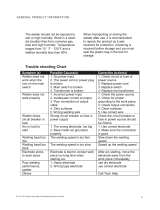
B-2
OPERATION
B-2
IDEALARC
®
DC-1500
Approximate Voltage Voltage Control Setting
22-24 2
34-36 4
46-48 6
56-60 8
2. Use the CV Submerged Arc mode for most sub-
merged arc welding. However, some high speed
welding procedures may perform better on the CV
Innershield mode.
3. The VV (CC) mode is available for high current,
large puddle submerged arc procedures that can-
not be done as well with the constant voltage
mode.
4. Air Carbon Arc Gouging or Cutting — For air
carbon arc gouging, the constant voltage
Innershield mode is used with the output control
set between 4 and max. depending on the applica-
tion, carbon size, etc. Up to 1/2” carbons, start with
the machine control set at 4 and increase as
required for long cable lengths. With 1/2” and 5/8”
carbons, short (100’) cable lengths can lead to
occasional trip out of the protection circuit when the
carbon is shorted to the work. Cutting back the out-
put setting will reduce the short circuit current and
minimize tripping. Longer cable lengths do an even
better job since this also reduces the short circuit
current but even more significantly permits raising
the open circuit voltage (by increasing control set-
ting) for smoother operation. See the table below
for optimum cable size and length.
TABLE B.1
If ever longer leads are used and the output control
is already set on max., the unit has reached its
maximum air carbon arc capability.
3/4” carbons are not recommended for use with the
DC-1500 because the high surge currents that
occur with this diameter can cause the DC-1500
fault protection circuitry to trip the machine off the
line, if the operator does not gouge in such a way
to limit the currents.
General Set-Up Procedures When Using DC-1500
and Lincoln Automatic Head NA-3
(Read the following and refer to Table B.3 in the
Operation Section.)
1. NA-3 — The NA-3 should be set for the mode
being used on the power source. If using either of
the CV modes, the NA-3 VV board switch should
be set for CV. If the power source is used in the VV
mode, then the NA-3 VV board mode switch should
be placed in the VV position.
All NA-3’s when used with the DC-1500 are capa-
ble of cold starting with the variable voltage board
mode switch in VV. Cold starting permits the wire
to be inches down to the work, automatically stop
and automatically energize the flux hopper valve.
All NA-3’s made after September 1976, are capable
of cold starting on either CV or VV settings of the
variable voltage board switch.
2. Arc striking with DC-1500 mode switch on CV
sub-arc or CV Innershield — There are a number
of basic techniques for good arc striking that apply
to all processes and power sources. It may not be
necessary in every application to follow these
guidelines, but when striking problems do occur,
following the suggestions below should provide
trouble-free starting. These procedures apply to all
single solid wire, Innershield wire, and Twinarc 1/8”
and 3/32” solid wire.
• Except for long stickout Innershield procedures
and Tiny Twinarc 1/16” procedures, an NA-3 start
board is not needed. If a start board is not need-
ed, it should be removed from the machine, or at
least disconnected and the logic board jumper
plug replaced. Leaving it connected makes the
setup for arc striking more difficult. Also, if a crater
board is not needed, it should be removed from
the NA-3 or at least electrically disconnected and
the jumper plug replaced.
• Cut electrode to a sharp point.
• For cold starts, make certain work piece is clean
and electrode makes positive contact with plate.
• For hot starts, travel should be started before wire
contacts the work (“on the fly” starting).
• Set NA-3 open circuit voltage control to approxi-
mately the same setting as the weld setting. For
initial test welds, choose the voltage setting
based on the Table B.2. Set the inch control to 2.
These are approximate settings only until the
welding procedure has been set.
It should be noted that with the DC-1500 the OCV
required for optimum starting is lower than that
required with other type power sources.
TABLE B.2
• Run a test weld, setting the proper current, volt-
age and travel speed.
Combined Total
Electrode and
Electrode
Carbon Typical
Work Lead Length
and Work
Size Current Range (Min) (Max) Lead Size
1/2” 600-1000 Amps 250’ 825’ 2 — 4/0
5/8” 800-1200 Amps 375’ 925’ 3 — 4/0






















